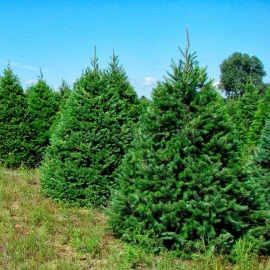







Pseudotsuga Menzies Organic Seeds (f. Green) (Pseudotsuga menziesii)
1.14 €
An evergreen coniferous tree originating from the western regions of North America, which reaches a height of 100m with a trunk thickness of up to 4m.
-
Pseudotsuga Menzies (form green) / Pseudotsuga menziesii
An evergreen coniferous tree native to the western regions of North America. A powerful, beautiful evergreen plant, reaching a height of 100 m with a trunk up to 4 m thick. Forms huge forests along the entire Pacific coast from British Columbia to California, Montana, Colorado, Texas and New Mexico.
The species is named after Archibald Menzies (1754-1842), a Scottish physician and biologist.
In the literature in Russian, the plant can be found under the names of Menzies' False Sugars, Tissolist Pseudosuga, Douglas Thissolist, Douglas Fir, Douglas Fir, Oregon Pine, Douglas Fir.
Treeup to 100 m high; trunk up to 4 m in diameter; the bark is smooth, on old trees it is tuberous and deeply wrinkled, on young trees it is smooth, with resin streaks; the crown of young trees is pin-shaped, flat with age; branches on young trees are raised, on old ones - horizontal; young shoots are glabrous, first orange-yellow, later red-brown to gray-orange. The needles are straight, less often bent, 2 - 3 cm long, blunt or sharp at the end, uncut, dark or green above, with gray and whitish stomatal canals below. Cones ovate-oblong, 5-10 cm long, scales are often slightly concave, about 2 cm wide; the cover scales protruding (in the typical coastal form var. viridis), straight lying (in the mountain form var. glauca), curved back, first light green, then light brown.
Outwardly, it resembles a large fir or spruce.
The crown is conical. The branches on young trees are raised, on old ones - horizontal. Young shoots are glabrous, first orange-red, later red-brown. The bark is brownish-gray, in young trees it is smooth, in old trees it is lumpy and deeply wrinkled.
The needles are dark gray-green, needle-like, flattened, straight, 2-3 cm long. Hanging cones, ovate, 5-10 cm long. The scales are bent. The seeds ripen in the first year.
Menzies' pseudo-slug, more precisely, its coastal form - Pseudo-slug tissolistnaya is today the second tallest tree in the world, after the Sequoia Evergreen. For older trees, the usual height is 60-75 m or more, with a trunk diameter of 1.5-2 m. Trees with a maximum height of 100-120 m with a trunk thickness of 4.5-6 m have also been documented.
The highest of living Douglas Fir, «Doerner Fir», (formerly known as Brummit fir), is 99.4 meters in height, the most broad, «Queets Fir», has a diameter at the base of the barrel 4.85 m.
Usually more lives 500 years, occasionally up to 1000 years or more.Cultivation of Menzies pseudo-slug
The most reliable way of reproduction of pseudo-suga is seed. It is better to sow seeds before winter immediately after harvest (end of September-October) to a depth of 2-3 cm. Seedlings in the first year do not show gigantism, but starting from the second they grow much more vigorously than spruce, pine, and fir of the same age. At the same time, the growth of trees in height is maintained until the end of life.
The false beetle is very undemanding to the conditions of detention: it is shade-tolerant, drought-resistant, unpretentious to soil fertility. But with all this, the growth rate and decorativeness of plants directly depend on the favorable location and soil conditions. The worst option is barren sandy loam soil, dryness and heavy shading. The most favorable option should be considered a powerful, high-humus moisture-absorbing light loam with neutral Phand the low standing of groundwater. If the soil substrate is specially prepared, then a mixture of cultivated garden loam, humus and sand in a ratio of 3: 2: 1 may be a good option. Well-drained loamy soils are a good starting base. On sandy loam soils, it is shown to prepare planting holes for plants with a diameter and depth of about a meter and fill them with the above fertile mixture.
Caring for such large trees as pseudo-lumber has the feature that it makes sense only until a certain age, while the plants are relatively small. Therefore, the favorable location outweighs all care efforts in importance. However, watering and fertilizing will allow young trees to quickly develop root and crown systems, which will further ensure their well-being. Fertilizer is shown to be applied in the spring in the form of humus or compost (2-3 buckets per square meter) under a shallow digging of the trunk circle. In plants, it makes sense to form irrigation holes in which precipitation would be retained. The soil of the near-stem space should be kept free of weeds, under a layer of moisture-retaining mulching material: peat, loose compost, etc.
